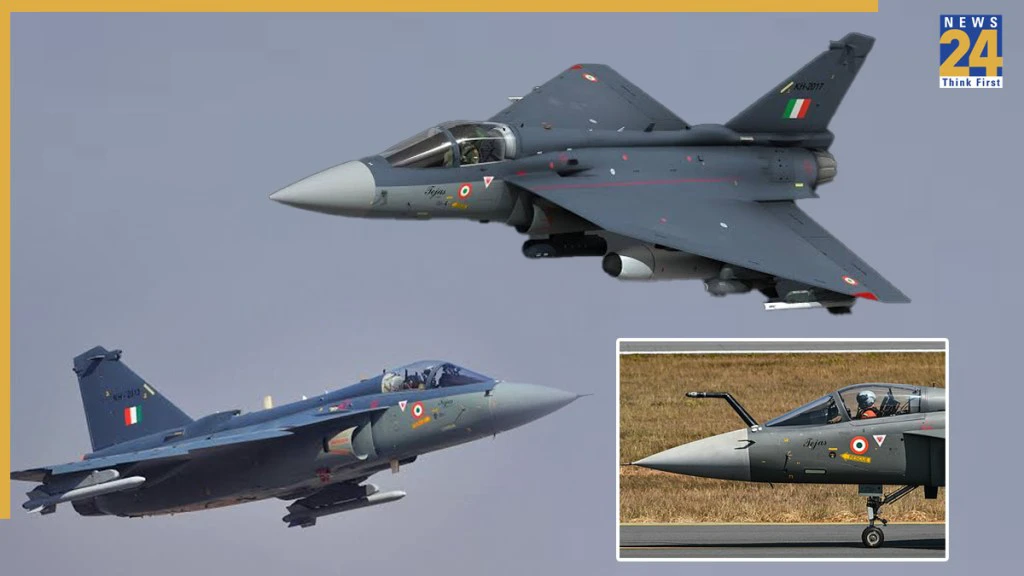That black smoke rising over Dubai’s Al Maktoum Airport on November 21st wasn’t just burning fuel. It was a dagger through the heart of every Indian watching.
Wing Commander Namansh Syal, a 34-year-old fighter pilot from the mountains of Himachal Pradesh, gave his life that afternoon when his Tejas Mk.1 fighter jet crashed during a daring low-level demonstration at the Dubai Airshow. Videos show the sleek machine twisting through the sky before plunging to earth in a fireball. The world gasped. Social media exploded with criticism. Trolls across borders sharpened their keyboards. But before we hang our heads in shame, let us take a deep breath and look at the bigger picture.
Wing Commander Syal was no ordinary pilot. Trained on the legendary MiG-21, experienced on the mighty Sukhoi Su-30MKI, he was among the finest aviators India has ever produced. His wife, Wing Commander Afshan, is also an IAF officer. Their six-year-old daughter Aarya will grow up knowing her father was a hero who died chasing the sky. When his remains arrived in Kangra, thousands gathered to salute a son who never disappointed anyone. His father Jagan Nath Syal said it simply, “The country has lost an ace pilot, and I have lost a young son.”
Now here is what the critics conveniently forget. In 24 years since its first test flight in 2001, the Tejas has crashed exactly twice. The first was in March 2024 near Jaisalmer due to engine seizure, and the pilot ejected safely. The second was this heartbreaking Dubai accident. Two crashes in over 12,000 fleet flying hours across more than two decades. Compare that with any fighter jet programme in the world, and you will find this record is actually quite remarkable.
Let us look across our western border. Pakistan’s beloved JF-17 Thunder, that Sino-Pakistani joint venture marketed as a budget fighter, has crashed five times since 2007. That is one crash roughly every three years since it entered service. The first crash in 2011 killed Squadron Leader Muhammad Hussain when his parachute failed to open. The most recent crash happened in June 2024 in Punjab’s Jhang district. Ironically, it was not the Pakistan Air Force that confirmed this accident but the British ejection seat manufacturer Martin-Baker, who announced it on social media. Pakistan kept quiet, hoping nobody would notice. According to aviation reports, around 40 JF-17 Block 1 and 2 fighters were grounded and classified as unfit to fly due to cracks in engine components. The Russian RD-93 engines powering these jets have become a major headache, with Western sanctions making spare parts nearly impossible to source.
And what about our dragon neighbour to the north? China keeps its military aviation statistics wrapped in secrecy, but glimpses tell a troubling story. In March 2025, a Chinese Navy J-15 “Flying Shark” crashed during training in Hainan province, with the pilot barely managing to eject. The J-10 “Vigorous Dragon” has seen at least six crashes between 2014 and 2016 alone, with engine failures from Russian-built AL-31 powerplants blamed for several. In November 2016, Captain Yu Xu, China’s first woman to fly the J-10, died during a mid-air collision during an aerobatics team practice. Reports suggest the Chinese Air Force loses multiple aircraft annually, but Beijing’s opacity hides the true numbers.
The honest truth is this: airshows are dangerous. Pilots push aircraft to their absolute limits with low loops, high-G turns, and split-second manoeuvres where even the smallest miscalculation can be fatal. The US Air Force Thunderbirds lost an F-16 in Idaho during an airshow performance. A Polish Air Force F-16 crashed at the Radom Air Show in August 2025, killing its pilot. These are world-class aircraft flown by elite aviators, yet accidents happen.
The Dubai Airshow organisers continued the event as a tribute to Wing Commander Syal’s passion for aviation, with final displays performed in his honour. US Air Force F-16 demonstration pilot Major Taylor Hiester cancelled his scheduled performance out of respect, saying he could not fly while a fellow aviator had fallen.
What makes this particularly stinging is the timing. India was showcasing the Tejas to potential export customers. Countries like Egypt, Philippines, and Argentina have shown interest. The crash undeniably hurts that marketing effort. But one accident does not erase years of proven performance. The Tejas has successfully participated in international exercises with the British Royal Air Force and UAE’s Exercise Desert Flag. During Tarang Shakti 2024, it intercepted a Eurofighter Typhoon in simulated combat. This is not a paper tiger. It is a genuine fourth-generation fighter with an AESA radar, modern avionics, and 59 percent indigenous content.
HAL is already producing the upgraded Tejas Mk-1A with 83 jets on order. The investigation will reveal what went wrong in Dubai, lessons will be learned, and the programme will emerge stronger. Remember, the F-35, America’s most advanced stealth fighter, has crashed eleven times since its first flight in 2001. The Eurofighter Typhoon prototype crashed eight years after its debut. Every great fighter programme faces setbacks.
Wing Commander Namansh Syal’s sacrifice stings deeply. But it should steel us, not shame us. When neighbours with far worse safety records throw stones, we should respond with facts, not embarrassment. India flies on, bolder and brighter than ever.
